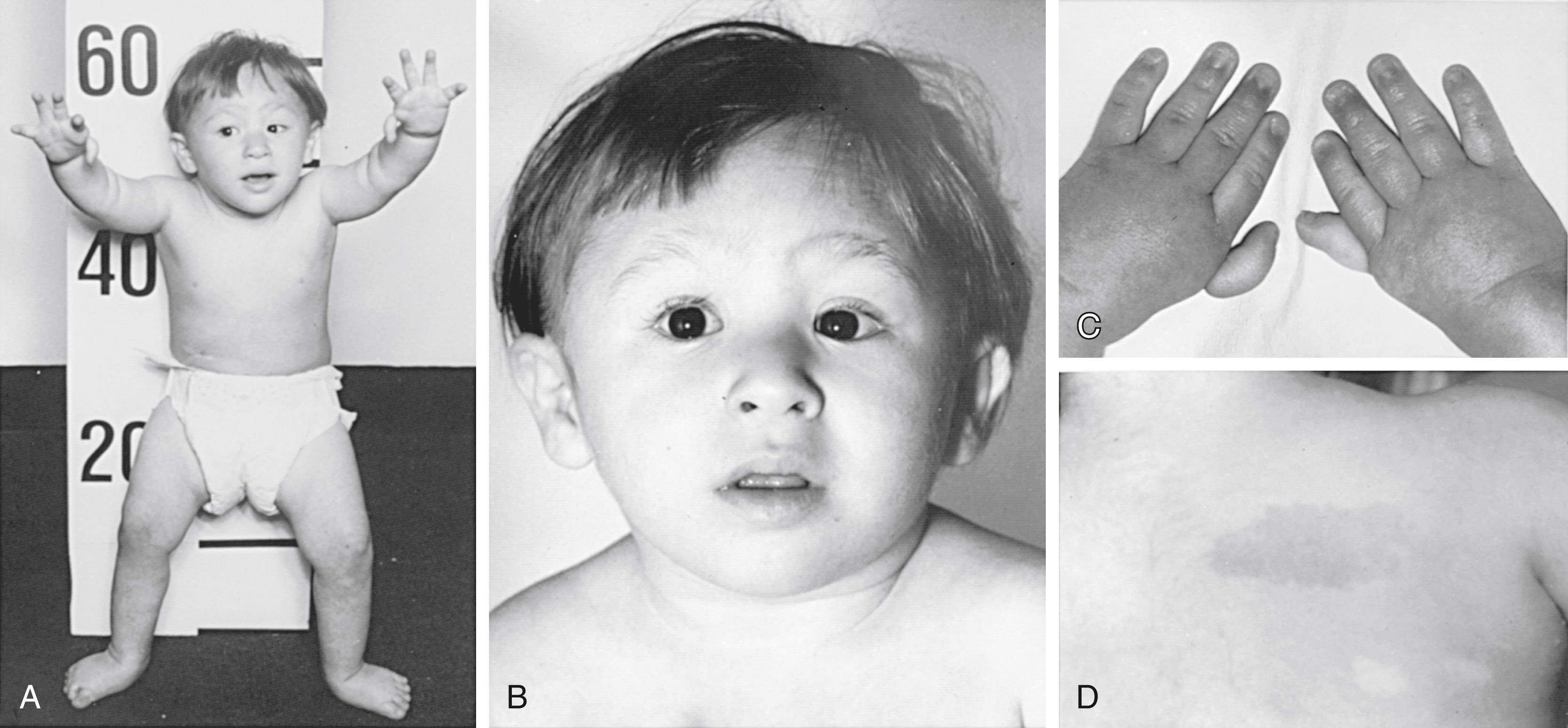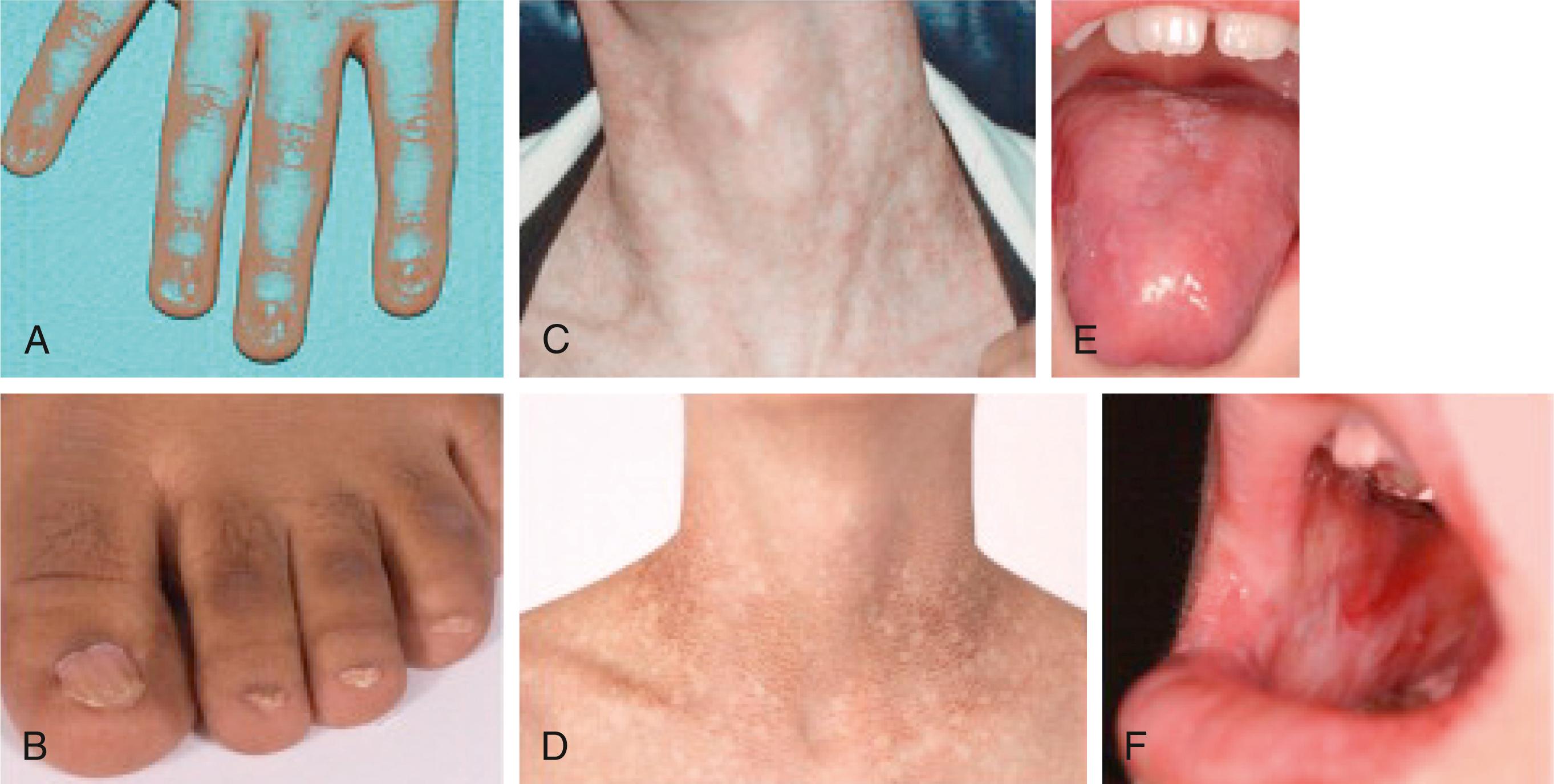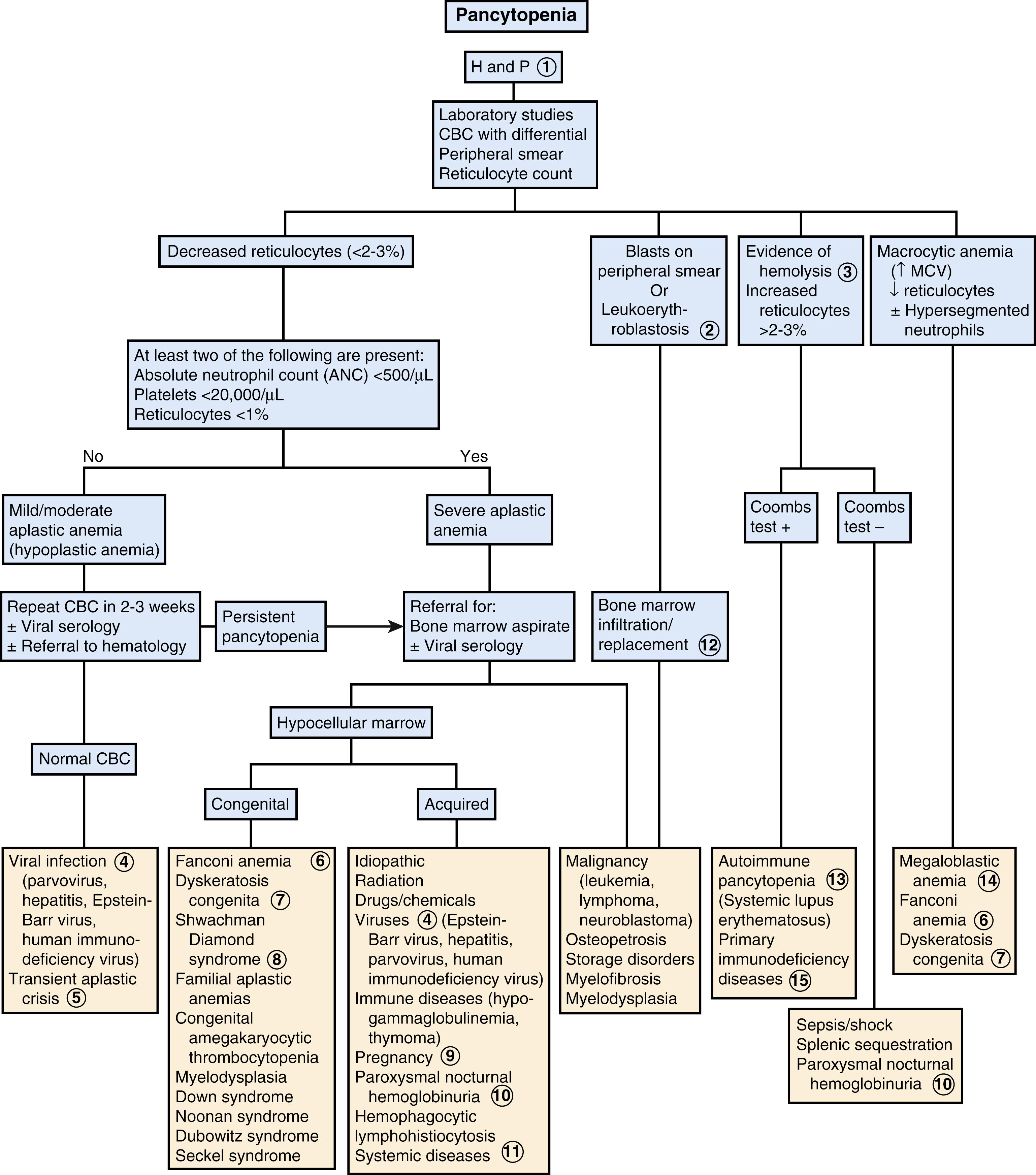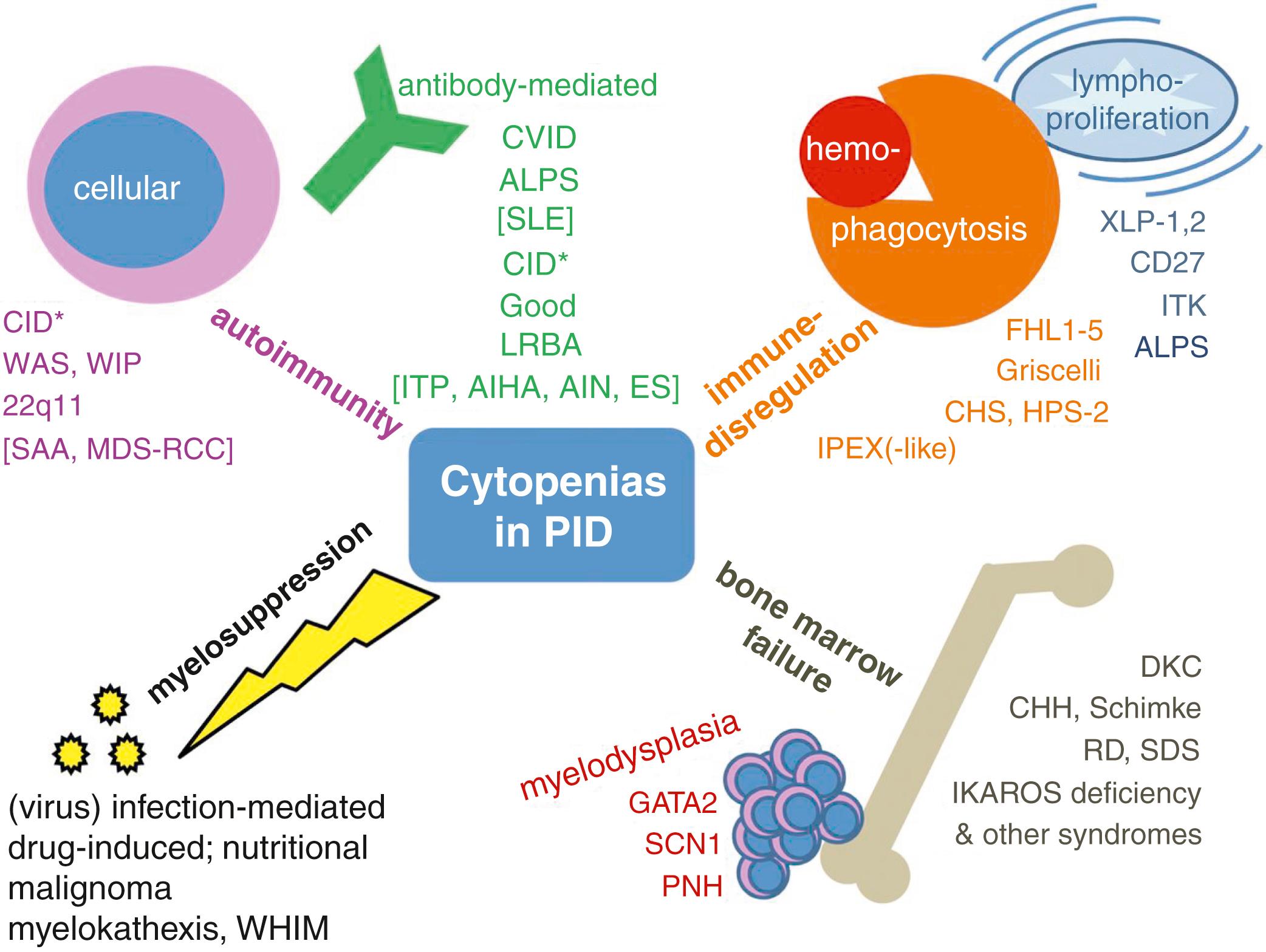Physical Address
304 North Cardinal St.
Dorchester Center, MA 02124
Pancytopenia is defined by a decrease in all peripheral blood cell lines, including leukocytes, red blood cells (RBCs), and platelets. All of these cells are produced by the bone marrow, and therefore an evaluation of the bone marrow is often required ( Table 50.1 ). Aplastic anemia is a serious cause of pancytopenia with multiple etiologies ( Tables 50.2 and 50.3 ).
| Pancytopenia with Hypocellular Bone Marrow |
|
| Pancytopenia with Cellular Bone Marrow |
|
| Hypocellular Bone Marrow ± Cytopenia |
|
∗ Pancytopenia in tuberculosis only rarely is associated with a hypocellular bone marrow at biopsy or autopsy. Marrow failure in the setting of tuberculosis is almost always fatal; exceptional patients probably had underlying myelodysplasia or acute leukemia.
|
| Gene | Inheritance | Condition |
|---|---|---|
| ABCB7 | X-linked | Sideroblastic anemia with ataxia |
| ACD | AR and AD | Dyskeratosis congenita |
| ADA2 (CECR1) | AR | Vasculitis, autoinflammation, immunodeficiency, and hematologic defects syndrome |
| AK2 | AR | Reticular dysgenesis |
| AP3B1 | AR | Hermansky-Pudlak type 2 |
| ATM | AR | Ataxia-telangiectasia |
| ATR | AR | Seckel syndrome |
| BLM | AR | Bloom syndrome |
| BRCA1, BRCA2 (FANCD1), BRIP1 (FANCJ), ERCC4 (FANCQ), FANCA, FANCB. FANCC, FANCD2, FANCE, FANCF. FANCG. FANCI, FANCL, FANCM, MAD2L2. PALB2 (FANCN), RAD51, RAD51C (FANCO), RFWD3, SLX4 (FANCP), UBE2T, XRCC2 | AR; except: FANCB – X-linked RAD51 – AD |
Fanconi anemia |
| CD40LG | X-linked | X-linked hyper-IgM syndrome |
| CLPB | AR | 3-methylglutaconic aciduria type VII, with cataracts, neurologic involvement, and neutropenia |
| CSF3R | AD, AR, and somatic | Severe congenital neutropenia 7 (SCN7) (germline); predisposition to myelodysplastic syndrome (somatic) |
| CTC1 | AR | Coats plus syndrome |
| CXCR2 | AR | Myelokathexis |
| CXCR4 | AD | WHIM syndrome |
| DKC1 | XR | Dyskeratosis congenita or Hoyeraal-Hreidarsson syndrome |
| DNAJC21 | AR | Familial bone marrow failure syndrome type 3 |
| EFL1 | AR | Shwachman-Diamond syndrome |
| EIF2AK3 | AR | Wolcott-Rallison syndrome |
| ELANE (ELA2) | AD | SCN1 |
| EPO | AR, AD | Diamond-Blackfan anemia; erythrocytosis |
| ERCC6L2 | AR | Familial bone marrow failure syndrome type 2 |
| G6PC3 | AR | SCN4, nonsyndromic SCN, Dursun syndrome |
| GATA1 | X-linked | GATA1-related X-linked cytopenia |
| GATA2 | AD | GATA2 deficiency |
| GFI1 | AD | SCN2 |
| HAX1 | AR | SCN3, Kostmann syndrome |
| HYOU1 | AR | Immunodeficiency and hypoglycemia |
| JAGN1 | AR | SCN6 |
| LAMTOR2 (ROBLD3) | AR | p14 deficiency |
| LIG4 | AR | LIG4 syndrome |
| LYST | AR | Chediak-Higashi syndrome |
| MPL | AR | Congenital amegakaryocytic thrombocytopenia |
| MRTFA (MKL1) | AR | Neutropenia with combined immune deficiency |
| MYSM1 | AR | Familial bone marrow failure syndrome type 4 |
| NAF1 | AD | Pulmonary fibrosis and emphysema |
| NBN | AR | Nijmegen breakage syndrome |
| NHEJ1 | AR | Severe combined immunodeficiency with microcephaly, growth retardation, and sensitivity to ionizing radiation |
| NHP2 (NOLA2) | AR | Dyskeratosis congenita |
| NOPIO (NOLA3) | AR | Dyskeratosis congenita |
| NSMCE3 | AR | Lung disease, immunodeficiency, and chromosome breakage syndrome |
| PARN | AD and AR | Dyskeratosis congenita; pulmonary fibrosis and/or bone marrow failure |
| POT1 | AD | Familial chronic lymphocytic leukemia |
| RAB27A | AR | Griscelli syndrome type 2 |
| RAC2 | AR | Neutrophil immunodeficiency syndrome |
| RBM8A | AR | Thrombocytopenia-absent radius syndrome |
| RMRP | AR | Cartilage-hair hypoplasia |
| RNF168 | AR | RIDDLE syndrome |
| RPL5, RPL9, RPL11, RPL15, RPL18, RPL26, RPL27, RPL31, RPL35, RPL35A, RPS7, RPS10, RPS15, RPS15A, RPS17, RPS19, RPS24, RPS26, RPS27, RPS27A, RPS28, RPS29, TSR2 | AD; except: TSR2 – X-linked |
Diamond-Blackfan anemia |
| RTEL1 | AD and AR | Dyskeratosis congenita |
| RUNX1 | AD and somatic | Familial platelet disorders (germline); acute myeloid leukemia (germline); predisposition to myelodysplastic syndrome/acute myeloid leukemia (somatic) |
| SAMD9 | AD | MIRAGE syndrome |
| SAMD9L | AD | Ataxia-pancytopenia syndrome |
| SBDS | AR | Shwachman-Diamond syndrome (SDS) |
| SLC37A4 | AR | Glycogen storage disease type IB |
| SMARCD2 | AR | Specific granule deficiency 2 |
| SRP54 | AD | Congenital neutropenia |
| SRP72 | AD | Familial bone marrow failure syndrome type 1 |
| STK4 | AR | STK4 deficiency |
| STN1 | AR | Coats plus syndrome with telomere defects |
| TAZ | X-linked | Barth syndrome |
| TCIRG1 | AR, AD | Osteopetrosis (AR), congenital neutropenia (AD) |
| TCN2 | AR | Transcobalamin II deficiency |
| TERC (hTR) | AD | Dyskeratosis congenita |
| TERF2IP | AD | Familial melanoma |
| TERT | AD and AR | Dyskeratosis congenita |
| TINF2 | AD | Classic or severe DC, Revesz syndrome, Hoyeraal-Hreidarrson syndrome; AD 3 |
| TP53 | AD and somatic | Familial bone marrow failure syndrome 5 (germline); transformation to myelodysplastic syndrome/acute myeloid leukemia in patients with Shwachman-Diamond syndrome (somatic) |
| USB1 | AR | Clericuzio-type poikiloderma with neutropenia |
| VPS13B | AR | Cohen syndrome; congenital neutropenia with retinopathy |
| VPS45 | AR | SCN5 |
| WAS | X-linked | Wiskott-Aldrich syndrome, X-linked |
| WDR1 | AR | WDR1 deficiency |
| WIPF1 | AR | Wiskott-Aldrich syndrome |
| WRAP53 (TCAB1, WDR79) | AR | Dyskeratosis congenita, Revesz syndrome, Hoyeraal-Hreidarrson syndrome |
Patients often present with fevers and infections related to leukocytopenia and/or neutropenia, anemia (pallor, tachycardia), and thrombocytopenia (bleeding, bruising, petechiae). In pediatrics, one must consider the age of the patient for normal ranges of cell lines, as these change with age ( Table 50.4 ).
| Age | Hb (g/dL) ∗ | HCT (%) ∗ | MCV (fL) ∗ | MCHC (g/dL RBC) ∗ | Reticulocytes | WBCs (×10 3 /mL) † | Platelets (10 3 /mL) † |
|---|---|---|---|---|---|---|---|
| 26–30 wk gestation ‡ | 13.4 (11) | 41.5 (34.9) | 118.2 (106.7) | 37.9 (30.6) | — | 4.4 (2.7) | 254 (180–327) |
| 28 wk | 14.5 | 45 | 120 | 31.0 | (5–10) | — | 275 |
| 32 wk | 15.0 | 47 | 118 | 32.0 | (3–10) | — | 290 |
| Term § (cord) | 16.5 (13.5) | 51 (42) | 108 (98) | 33.0 (30.0) | (3–7) | 18.1 (9–30) || | 290 |
| 1–3 days | 18.5 (14.5) | 56 (45) | 108 (95) | 33.0 (29.0) | (1.8–4.6) | 18.9 (9.4–34) | 192 |
| 2 wk | 16.6 (13.4) | 53 (41) | 105 (88) | 31.4 (28.1) | — | 11.4 (5–20) | 252 |
| 1 mo | 13.9 (10.7) | 44 (33) | 101 (91) | 31.8 (28.1) | (0.1–1.7) | 10.8 (4–19.5) | — |
| 2 mo | 11.2 (9.4) | 35 (28) | 95 (84) | 31.8 (28.3) | — | — | — |
| 6 mo | 12.6 (11.1) | 36 (31) | 76 (68) | 35.0 (32.7) | (0.7–2.3) | 11.9 (6–17.5) | — |
| 6 mo–2 yr | 12.0 (10.5) | 36 (33) | 78 (70) | 33.0 (30.0) | — | 10.6 (6–17) | (150–350) |
| 2–6 yr | 12.5 (11.5) | 37 (34) | 81 (75) | 34.0 (31.0) | (0.5–1.0) | 8.5 (5–15.5) | (150–350) |
| 6–12 yr | 13.5 (11.5) | 40 (35) | 86 (77) | 34.0 (31.0) | (0.5–1.0) | 8.1 (4.5–13.5) | (150–350) |
| 12–18 yr | |||||||
| Male | 14.5 (13) | 43 (36) | 88 (78) | 34.0 (31.0) | (0.5–1.0) | 7.8 (4.5–13.5) | (150–350) |
| Female | 14.0 (12) | 41 (37) | 90 (78) | 34.0 (31.0) | (0.5–1.0) | 7.8 (4.5–13.5) | (150–350) |
| Adult | |||||||
| Male | 15.5 (13.5) | 47 (41) | 90 (80) | 34.0 (31.0) | (0.8–2.5) | 7.4 (4.5–11) | (150–350) |
| Female | 14.0 (12) | 41 (36) | 90 (80) | 34.0 (31.0) | (0.8–4.1) | 7.4 (4.5–11) | (150–350) |
‡ Values are from fetal samplings.
§ 1 mo, capillary hemoglobin exceeds venous: 1 hr: 3.6-g difference; 5 day: 2.2-g difference; 3 wk: 1.1-g difference.
The predisposing risk factors for pancytopenia may help guide the diagnostic approach ( Tables 50.5 and 50.6 ).
| General Cause | History Clues to Review |
|---|---|
| Viral | Fever, viral symptoms, sick contacts, rashes, conjunctivitis, jaundice |
| Malignant | Fevers, bony pain, weight loss, lymphadenopathy, hepatosplenomegaly, night sweats |
| Liver failure | Jaundice, abdominal pain, encephalopathy |
| Environmental | History of radiation or chemotherapy, environmental toxins |
| Medication | See Table 50.6 |
| Immunodeficiency | Recurrent or opportunistic infections, skin infections, mouth sores, eczema, failure to thrive, positive newborn screen |
| Dietary | Vegan diet, goat milk ingestion, short bowel syndrome |
| Genetic | Bone marrow failure syndromes; see Table 50.3 |
| I. Agents That Regularly Produce Marrow Depression as a Major Toxic Effect When Used in Commonly Used Doses or Normal Exposures |
|
| II. Agents Probably Associated with Aplastic Anemia but with a Relatively Low Probability Relative to Their Use |
|
| III. Agents More Rarely Associated with Aplastic Anemia |
|
In addition to a thorough personal history review, a family history should also include questions related to congenital anomalies, syndromes associated with leukemias, thalassemias, sickle cell disease, and early or unusual childhood illnesses or death in relatives.
Patients with isolated pancytopenia might present with evidence of anemia and thrombocytopenia including pallor, petechiae, and purpura or with more severe hemorrhages. Additionally, if leukopenia or neutropenia is present, they might present with mild or severe infections. Symptoms such as fever, rhinorrhea, cough, congestion, conjunctivitis, lymphadenopathy, hepatosplenomegaly, and rash can be seen in common viral illnesses, cytomegalovirus (CMV) or Epstein-Barr virus (EBV) infections, and acute leukemia. One should also look for signs of jaundice or scleral icterus. Hepatomegaly and splenomegaly might be present and can be found in liver disease or in malignant causes, such as acute leukemias.
Because there are several syndromes associated with pancytopenia, a careful review for congenital anomalies is important ( Tables 50.7 and 50.8 and Figs. 50.1 and 50.2 ).
Skin (40%)
Body (40%)
Upper Limbs (35%)
(1%): dysplastic or absent
Gonads
Other Skeletal Anomalies
|
Eyes (20%)
Ears (10%)
Kidney (20%)
Gastrointestinal System (5%)
Urogenital
Cardiopulmonary System (6%)
Central Nervous System (3%)
|
∗ Abnormalities are listed in the approximate order of frequency within each category.
Adapted from Shimamura A, Aher BP. Pathophysiology and management of inherited bone marrow failure syndromes. Blood Rev . 2010;24:101–122.
From Nelson Textbook of Pediatrics . 21st ed. Philadelphia: Elsevier; 2020:2571, Table 495.2.
| Disease | Supportive Clinical Findings | Supportive Laboratory Findings | Inheritance Pattern |
|---|---|---|---|
| Fanconi anemia | Skeletal abnormalities (radius, thumb); small stature; urogenital abnormalities; 40% with no physical findings | Increased chromosomal breakage in response to mitomycin C or diepoxybutane | AR (most) or XLR |
| Dyskeratosis congenita | Leukoplakia; nail dystrophy; lacy skin pigmentation; pulmonary fibrosis | Genetic testing (a negative result does not rule out disease) | AR, XLR, or AD |
| Shwachman-Diamond syndrome | Exocrine pancreatic insufficiency | Genetic testing (a negative result does not rule out disease); normal sweat chloride | AR |
| Congenital amegakaryocytic thrombocytopenia | Sequelae of severe thrombocytopenia | Genetic testing (a negative result does not rule out disease); elevated thrombopoietin levels | AR |
| Hemophagocytic lymphohistiocytosis | Fever; splenomegaly; hepatitis; neurologic symptoms; rash | Hemophagocytosis; hypertriglyceridemia; hypofibrinogenemia; low/absent NK-cell activity; elevated serum ferritin; soluble CD25 >2,400 U/mL | AR or XLR |


( Tables 50.3, 50.8, 50.9, and 50.10 and Fig. 50.3 )
| Syndrome | Genes |
|---|---|
| FA | FANC: A, B, C, D1/BRCA2, D2, E, F, G, I, J, L, M, N, O |
| DC | X-linked: DKC1 AD: TINF2, TERC, TERT AD: NOP10, NHP2 |
| SDS | SBDS |
| CAMT | MPL |
| CBC, differential, peripheral blood smear review Reticulocyte count |
|
| Cell destruction | Direct Coombs test, haptoglobin, LDH, hemoglobinuria, total bilirubin |
| Cell consumption | PT, PTT, fibrinogen, creatinine |
| Viral marrow suppression | CMV, EBV, HIV, coronavirus disease 2019 (COVID-19), brucellosis, TB, Q fever, Legionnaires disease, hepatitis, parvovirus, dengue, measles, mumps, rubella, varicella, influenza A |
| Bone marrow evaluation Stains, chromosomal and flow cytometry Cellularity, myelofibrosis, infiltrative process, storage diseases |
|

Fanconi anemia (FA) is an autosomal recessive genetic disorder associated with congenital anomalies, cancer predisposition, and pancytopenia due to bone marrow failure (see Fig. 50.1 ). The classic physical exam findings include short stature, skin hyperpigmentation, and upper limb anomalies (such as absent, hypoplasia, or bifid thumb). Because ∼50% of patients with FA have normal physical findings, they are often undiagnosed until they present with hematologic abnormalities. This is typically in the first decade of life.
The test of choice for FA detects chromosomal breakage in cells exposed to diepoxybutane (DEB) and mitomycin C (MMC), cross-linking agents. There are multiple genes in the FA pathway and their protein products are involved in the DNA damage recognition and repair pathways; these lead to the chromosome fragility seen in FA (see Tables 50.3 and 50.10 ).
Marrow failure classically begins with thrombocytopenia followed by granulocytopenia, macrocytosis, and then macrocytic anemia. The marrow will often show decreased or absent megakaryocytes, hypocellularity, and fatty replacement. About 10% of patients will present with acute myeloid leukemia (AML). Because of the fragility to alkylating agents, these patients cannot be treated with the typical intensive therapy used in AML.
The curative therapy for FA is hematopoietic stem cell transplantation (HSCT). The HSCT therapy must avoid the associated chromosome fragility seen in FA, and the timing of transplant is often delayed as long as safely possible. Long-term survival outcomes following a matched sibling transplant is ∼80%.
Dyskeratosis congenita (DC) is an inherited (X-linked, autosomal recessive or dominant) bone marrow failure syndrome (see Tables 50.3 and 50.10 ). Patients first present with lacy skin pigmentation on the face, neck, chest, and arms and nail dystrophy followed by oral mucosal leukoplakia (see Fig. 50.2 ). Marrow failure will become apparent by their teen years.
Telomeres protect the ends of chromosomes; their length decreases with each cell cycle. Stem cells are able to activate telomerase, which allows for self-renewal. Gene variants seen in DC lead to inheritance of short telomeres and defects in the maintenance of telomeres, leading to stem cell exhaustion and eventually producing pancytopenia.
Patients will initially present with isolated thrombocytopenia, which will then evolve into pancytopenia. There is also macrocytosis and elevated fetal hemoglobin levels. In addition to hypocellularity of marrow, there can be signs of myelodysplasia or leukemia.
The anabolic steroid oxymetholone can improve marrow function. About 60% of patients will respond to this therapy, which can have a long-lasting effect. HSCT can be used in DC; however, the survival rate remains poor at 50%. There is significant morbidity and mortality following HSCT specific to DC including pulmonary fibrosis and gastrointestinal (GI) bleeding secondary to vascular anomalies.
Shwachman-Diamond syndrome (SDS) is an autosomal recessive inherited disorder. The typical clinical characteristics include exocrine pancreas insufficiency, which presents as fat malabsorption; skeletal changes including delayed bone maturation, metaphyseal dysostosis, short or flared ribs, and bifid thumbs; and bone marrow failure ( Table 50.11 ).
Data from Ginzberg H, Shin J, Ellis L, et al. Shwachman syndrome: phenotypic manifestations of sibling sets and isolated cases in a large patient cohort are similar. J Pediatr . 1999;135:81–88; Cipolli M, D’Orazio C, Delmarco A, et al. Shwachman’s syndrome: pathomorphosis and long-term outcome. J Pediatr Gastroenterol Nutr . 1999;29:265–272; and Kuijpers TW, Alders M, Tool AT, et al. Hematologic abnormalities in Shwachman-Diamond syndrome: lack of genotype-phenotype relationship. Blood . 2005;106:356–361.
From Nelson Textbook of Pediatrics . 21st ed. Philadelphia: Elsevier; 2020:2573, Table 495.3.
| Clinical Feature | % Present |
|---|---|
| Hematologic ∗ | |
| Neutropenia | 90% |
| Severe (≤500/μL) | 46% |
| Anemia | 46% |
| Thrombocytopenia | 42% |
| Pancytopenia | 21% |
| Gastrointestinal | |
| Exocrine pancreatic insufficiency ∗ | 98% |
| Liver (elevated transaminases) | 61% |
| Skeletal abnormalities | 70% |
| Metaphyseal dysostosis | 53% |
| Rib cage abnormalities | 35% |
| Short stature (<3rd percentile) | 66% |
∗ Hematologic abnormalities and exocrine pancreatic insufficiency are defining features of SDS, thus the near-100% incidence of these findings.
The pathologic gene SBDS seen in SDS is involved in ribosomal biogenesis, which is associated with pancytopenia, although the exact mechanism is not completely understood. Failure of pancreatic acinar development leads to fatty infiltration of the pancreas and associated exocrine dysfunction. Marrow failure is a result of dysfunctional stem cells, apoptosis of progenitor cells, and inability of the microenvironment to support hematopoiesis. Diagnosis is made based on clinical findings and genetic variant analysis for SBDS .
The most common hematologic finding in SDS is neutropenia, which predisposes to bacterial and fungal infections. About 10–65% of patients will present with pancytopenia; the majority of patients will have elevated fetal hemoglobin levels. Marrow cellularity can be variable; there is also a risk for myelodysplastic syndrome (MDS) and AML.
Management of SDS includes granulocyte colony-stimulating factor (G-CSF) for patients with severe neutropenia as well as transfusions for anemia and thrombocytopenia. The management of exocrine pancreatic insufficiency involves oral pancreatic enzyme replacement and fat-soluble vitamin supplements. HSCT is used in SDS with improved outcomes if performed prior to the development of leukemia, but data are limited and outcomes remain poor.
Congenital amegakaryocytic thrombocytopenia (CAMT) is an autosomal recessive disorder that begins in infancy with isolated thrombocytopenia. Patients with CAMT present with signs of thrombocytopenia, cerebellar and cerebral atrophy, developmental delay, and various congenital heart defects. MPL is a gene for the receptor of thrombopoietin that impacts megakaryocytic proliferation as well as apoptotic regulation and survival of stem cells. Pathologic gene variants of MPL have different effects on thrombopoietin receptor function, which produces a wide spectrum of severity.
The marrow findings will initially demonstrate amegakaryocytosis with normal cellularity. Among patients who progress to pancytopenia, the marrow cellularity decreases, and fatty infiltration is noted. These patients are also at risk for development of MDS and AML. Androgens and corticosteroids have been used to treat pancytopenia with some improvement, but HSCT remains the only curative option.
There are several other genetic syndromes that can develop pancytopenia. These include Down syndrome, Noonan syndrome, Dubowitz syndrome, Seckel syndrome, reticular dysgenesis, Schimke immunoosseous dysplasia, cartilage-hair hypoplasia, and familial aplastic anemia ( Table 50.12 ). In addition, cytopenias including pancytopenia may occur in primary immunodeficiency diseases ( Fig. 50.4 ). These include common variable immunodeficiency (CVID), autoimmune lymphoproliferative syndrome (ALPS), and immune disregulation polyendocrinopathy enteropathy X-linked (IPEX) and IPEX-like syndromes.
| Syndrome | Classic Clinical Features | Possible Bone Marrow Findings |
|---|---|---|
| Down syndrome | Up-slanted palpebral fissures, flattened nasal bridge, nuchal folds, single palmar flexion crease, clinodactyly of the fifth finger, hypotonia | Aplastic anemia MDS Acute leukemias |
| Noonan syndrome | Hypertelorism, ptosis, short neck, low-set ears, short stature, congenital heart disease, and multiple skeletal and hematologic abnormalities | JMML Amegakaryocytic thrombocytopenia Pancytopenia |
| Dubowitz syndrome | Eczema, small stature, mild microcephaly, micrognathia | Pancytopenia Hypoplastic anemia Bone marrow hypoplasia Aplastic anemia |
| Seckel syndrome | Growth failure, developmental delay, microcephaly, hypoplastic face with prominent nose | Aplastic anemia Malignancies |
| Reticular dysgenesis | Severe combined immunodeficiency with congenital agranulocytosis | Lymphopenia and neutropenia Variable anemia and thrombocytopenia Aplastic anemia |
| Schimke immunoosseous dysplasia | Pigmentary skin changes, discolored and configured teeth, renal dysfunction, nephrotic syndrome | Pancytopenia |
| Cartilage-hair hypoplasia | Metaphyseal dysostosis and other skeletal findings; short-limbed dwarfism; fine, sparse hair; GI abnormalities | Macrocytic anemia Neutropenia, lymphopenia, lymphoma |

Acquired aplastic anemia, a rare but severe hematologic disorder, is different from inherited bone marrow failure syndromes and can be a result of drugs, chemicals, radiation, infections, or immune disorders (see Tables 50.1 and 50.2 ). A bone marrow evaluation reveals hypocellularity; severity is graded based on the Camitta criteria ( Table 50.13 ).
| Moderate or Nonsevere | Decreased Bone Marrow Cellularity and Cytopenias but not Fulfilling Severe Criteria |
|---|---|
| Severe | Bone marrow cellularity <25% AND at least two of the following:
|
| Very severe | Severe criteria AND
|
There must be a thorough review of drug and chemical exposures (see Table 50.6 ). Medications can result in pancytopenia either by direct toxicity, metabolite-driven toxicity, or antibody-mediated destruction. Chemotherapeutic agents, radiation, benzene, chloramphenicol, antiepileptics, gold, nonsteroidal antiinflammatory drugs (NSAIDs), and several antibiotics are notable exposures.
Become a Clinical Tree membership for Full access and enjoy Unlimited articles
If you are a member. Log in here